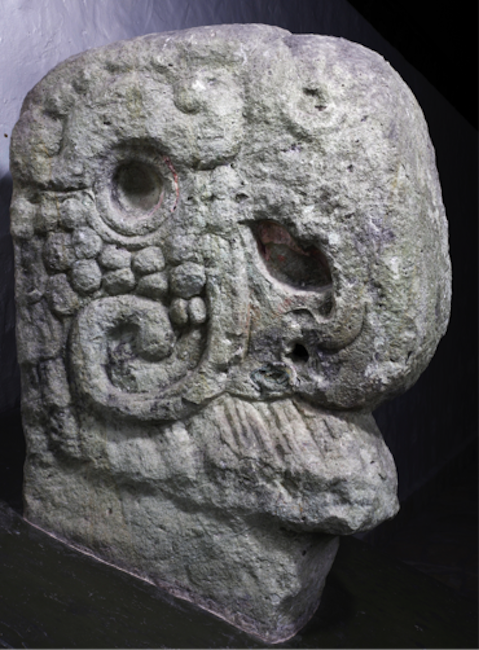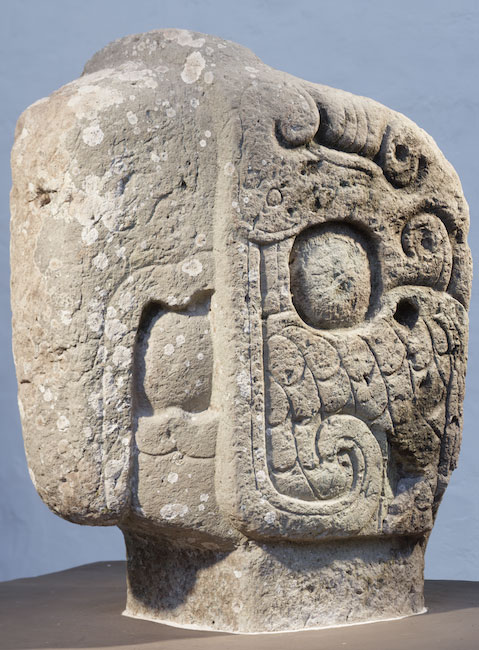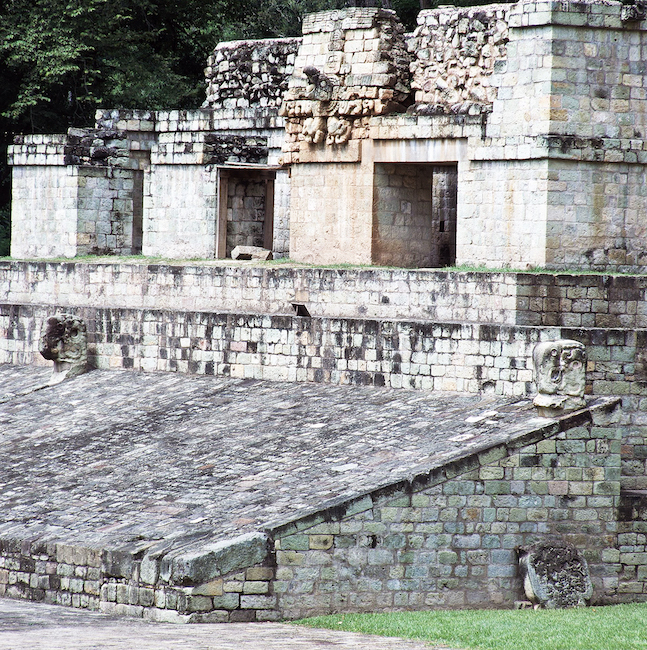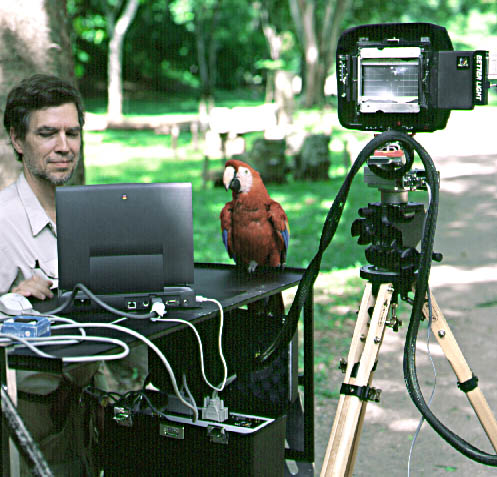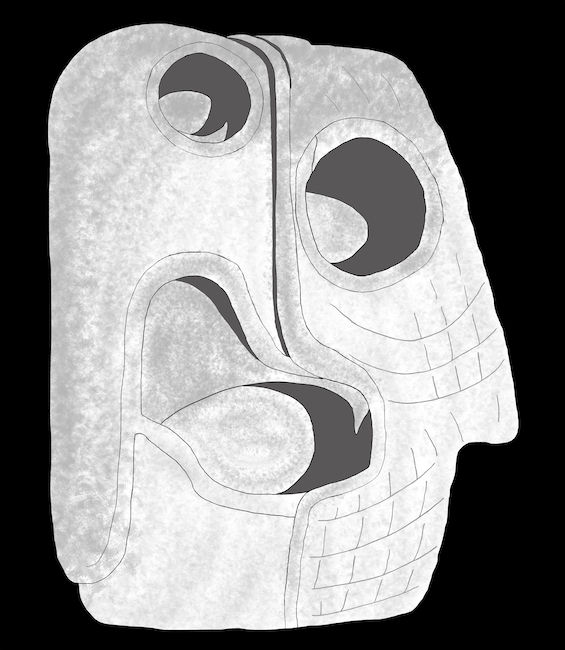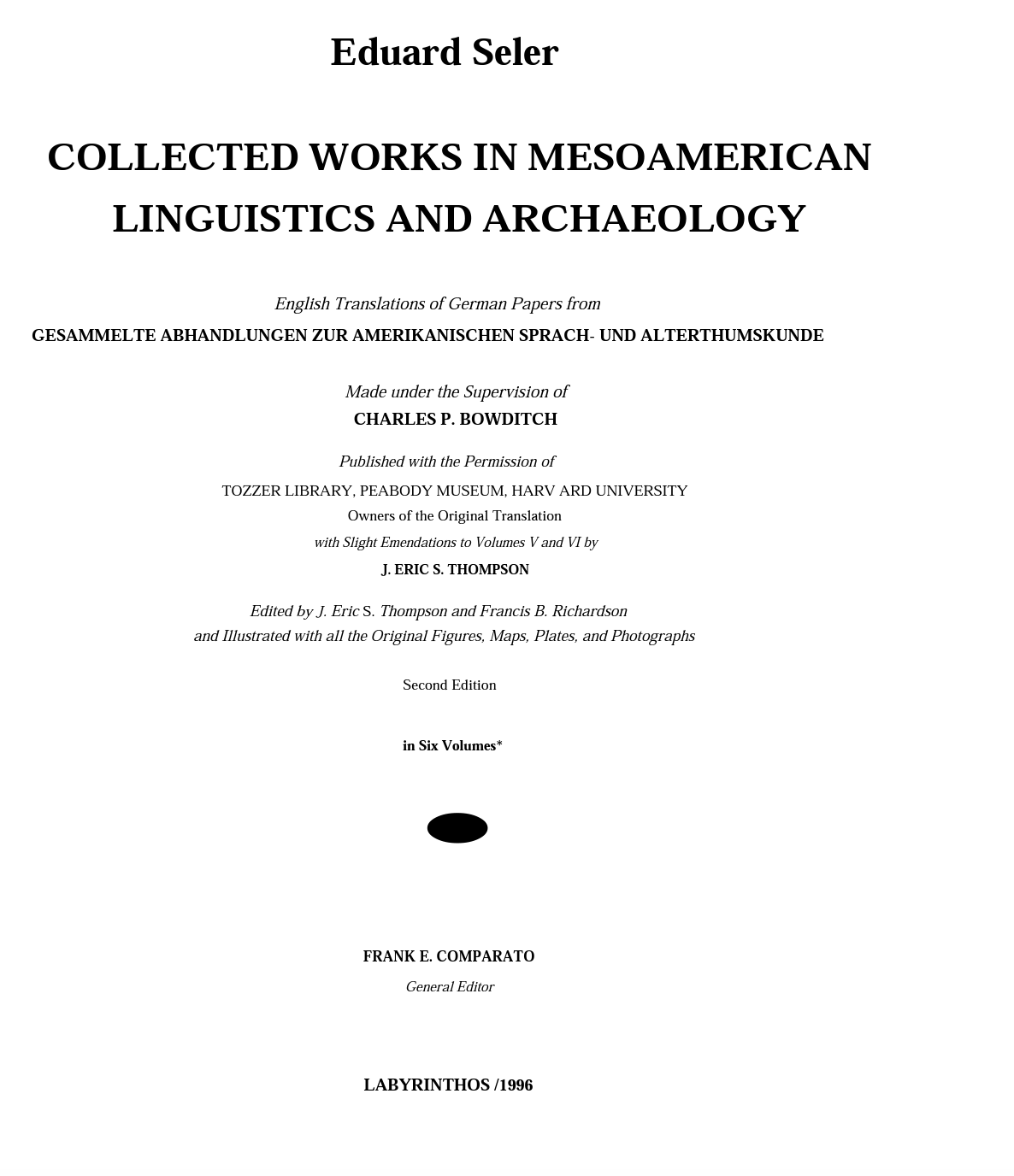Scarlet Macaws: more images than Slicer Bat (of the Popol Vuh) at Copan
Although a bat is the Emblem Glyph of Copan, there are more large sculptures of the scarlet macaw than the one human-sized 3-dimensional sculpture of the Slicer Bat in the Copan sculpture museum. So the scarlet macaw is an easy way to learn iconography (the study of symbolism) and epigraphy (the study of hieroglyphic writing). To learn more about Maya archaeology it helps to learn about the birds, mammals, reptiles and other creatures that are featured in Maya mythology. At Copan crocodiles, snakes, raptors are pictured in addition to macaws and bats.
We have a report-in-progress on the tenoned stone macaw goalstones of the Copan ballcourt (Hellmuth in press). So in the present web page we just show sample images and have a bibliography of suggested reading on macaws at the end.
These Macaw ballcourt goalstones have been published hundreds of times, including in books by Barbara Fash (her 2011: page 94 shows early and final style of macaw sculptures associated with the ballcourt of Copan). But curiously, the most complete book on Maya Sculpture of Copan (Baudez 1994) has no photo nor drawing of any of the macaw sculptures. That is one of many reasons why we have a FLAAR Report in-progress to show all the ballcourt architecture and the related macaw sculptures there and in the marvelous sculpture museum in the park.
Epigraphy and Linguistics of Mo’ one Hieroglyphic Word for Macaw
Since there are about two dozen different Mayan languages, there are several different words for macaw. But since most Maya hieroglyphs were written in a “language of the elite class” the word usually presented by Maya glyphs is transalted by epigraphers as Mo’.
There are dozens of workbooks for the decades of hieroglyphic conferences and training courses in the USA and in Germany. Each will show one or two illustrations of the Mo’ macaw glyph.
Unexpectedly, Macaws are featured as ballcourt sculpture of the southern ballcourt of Xochicalco
Xochicalco, over a thousand kilometers north of Copan, Honduras, has a beautifully sculpted macaw head.
Macaws were traded all the way north to outside Mesoamerica
Remains of macaws have been found traded far north. One example is Paquimé. Paquimé is along the Rio Camas Grandes in northwestern Chihuahua, Mexico. The Mexico-USA border is only about 150 miles north.
There are many lectures and web pages and reports on this. Here are two:
www.nationalgeographic.com/science/article/news-ancient-dna-chaco-canyon-pueblo-macaws-archaeology
www.smithsonianmag.com/science-nature/macaw-breeding-center-supplied-plumage-180969982/
Macaws of the Maya ecosystems and Macaws pictured in Classic Maya art
We have several additional web pages on macaws as pictured in Classic Maya art (especially Early Classic). You can find the Hellmuth article on Macaws and Parrots in 3rd-9th century Mayan Art on this link:
https://www.revuemag.com/macaws-and-parrots-in-3rd-9th-century-mayan-art/
Lots of Macaws all around you if you visit Copan archaeology park
Scarlet macaws are all over the place near the friendly town of Copan Ruinas, Honduras. If you are standing still a macaw will often land on your outstretched arm.
You can easily drive here from Guatemala City, or see if there are shuttles from Guatemala to Copan Ruinas, Honduras.
Estación Biológica Las Guacamayas, Macaw Biology Research Station
The absolutely most comfortable place to do macaw research (and to study other nearby flora, fauna and wetlands ecosystems) is the Estación Biológica Las Guacamayas. This is on the shore of Rio San Pedro in northwestern Peten.
Contact info is on their:
https://www.lasguacamayas.org/portal/us/
|
Contacts E-mail: info@guacamayastravel.com Phones: +502 3106-3568 y +502 3187-6255 Whats app: https://wa.link/k1tddb The team here are super-helpful and hospitable:
Additional tour guides are: Jeovany Nolberto Tut Pacheco, Carlos Cuz Coc and René de Jesús Mauricio Tec. The food in the hotel restaurant is tasty. The capable and friendly cooks are Glenda Suseli Sinturión García and Vilma Elizabeth Pop. |
Macaws in the Maya Codices and Classic Maya Art (Tozzer and Allen 1910)
The major change needed for this year 1910 book is to estimate that few if any are the Blue Macaw; today we estimate that all are the Scarlet Macaw, but zoo-archaeologists need to find bones in Maya middens and offerings and let everyone know whether the military macaw was in the Peten Lowlands. Since there were trade routes all the way south to Costa Rica, anything and everything is possible.
Blue Macaw (Ara militaris). A large macaw (Maya, mox or ṭuṭ) is undoubtedly pictured in the figures in Pl. 25. The least conventionalized drawing found is that shown in Dresden 16c (Pl. 25, fig. 2), a bird characterized by long narrow tail feathers, a heavy bill, and a series of scale-like markings on the face and about the eye. Further conventionalized drawings are found in Pl. 25, figs. 3, 10, 13, and Pl. 26, fig. 1. In all these the tail is less characteristic, though composed of long, narrow feathers, and the facial markings are reduced to a ring of circular marks about the eye. These last undoubtedly represent, as supposed by Stempell, the bare space about the eye found in certain of these large parrots. In addition, the space between the eye and the base of the bill is partially bare with small patches of feathers scattered at somewhat regular intervals in rows. It is probable that this appearance is represented by the additional round marks about the base of the bill in Pl. 25, figs. 1, 2, 5, 8, the last two of which show the head only. There has hitherto been some question as to the identity of certain stone carvings, similar to that on Stela B from Copan, of which a portion is shown in Pl. 25, fig. 8. This has even been interpreted as the trunk of an elephant or a mastodon, but is unquestionably a macaw’s beak. In addition to the ornamental crosshatching on the beak, which is also seen on the glyph from the same stela (Pl. 25, fig. 5), there is an ornamental scroll beneath the eye which likewise is crosshatched and surrounded by a ring of subcircular marks that continue to the base of the beak. The nostril is the large oval marking directly in front of the eye.
Several paragraphs more, but what we show here is the crucial text.
Bibliography on Macaws in Copan sculpture
I estimate about half the books on Copan show either the macaw mosaic stone sculpture, the stucco macaw, or the macaw tenoned goal stones of the ballcourt. Curiously, not many archaeology or epigraphy or iconography reports focus on macaws in depth (which is why we are preparing this web page plus upcoming reports). And the comprehensive monography by Baudez (1994) nowhere shows the macaw sculptures of the ballcourt.
- 1991
- Scribes, Warriors and Kings, the City of Copan and the Ancient Maya. Thames and Hudson. 192 pages.
Expertly reconstructed frontal macaw façade of the ballcourt is shown in Figure 80 (page 125).
Bibliography on Scarlet Macaw, focused on Mesoamerica
Monographs on parrots and macaws that includes these birds of Mexico, Belize, Guatemala, Honduras, El Salvador, and Costa Rica.
First, Google Las Guacamayas Biological Research Station; then Google in Spanish, There is a macaw research station on the Rio San Pedro Martyr, El Peten. Just realize that macaws come here only during certain seasons related to the macaw life cycle, weather cycle (which changes slightly each year). So communicate with Las Guacamayas in advance, Estación Biológica Las Guacamayas. But at Copan Ruinas in Honduras and at Macaw Mountain Bird Park & Nature Reserve a few minutes away from Copan ruinas, the macaws are there in Honduras 24 hours a day all year.
- 2010
- Parrots of the World. Princeton Field Guides. 336 pages.
- 1998
- Parrots: a guide to parrots of the world. Yale University Press. 584 pages.
Pertinent articles or books on birds in general
(of Mesoamerica) that show parrots and macaws
- 1992
- The Birds of Tikal, An Annotated Checklist for Tikal National Park and Peten, Guatemala. TAMU Press. 168 pages.
- 1998
- A Field Guide to the Birds of Mexico and Adjacent Areas Belize, Guatemala, and El Salvador. 3rd edition. University of Texas Press. 285 pages.
- 1995
- A Guide to the Birds of Mexico and Northern Central America. Oxford University Press. 1010 pages.
- 2004
- Birds of Belize. University of Texas Press. 317 pages.
- 1999
- A Field Guide to Mexican Birds: Mexico, Guatemala, Belize, El Salvador. Peterson Field Guide. Houghton Mifflin Harcourt. 320 pages.
- 2002
- Aves del Valle de Aburra. Sociedad Antioqueña de Ornitología - SAO. Segunda Edición. Medellín, Colombia. 136p.
- 2006
- Birds of Mexico and Central America. Princeton University Press. 336 pages.
- 2004
- Delineating Pattern and Process in Tropical Lowlands: Mealy Parrot Migration Dynamics as a Guide for Regional Conservation Planning. PhD dissertation. Oregon State University, 226 pages.
Scarlet Macaws in Iconography and Epigraphy, Suggested Reading
There are lots of articles that mention macaws (but not yet a book; that’s what I am working on). There are many monographs on Maya hieroglyphs that have a one-line entry for Mo’, Macaw. I show below just samples to get you started.
- 1936
- Ethnological and Historical Implications of certain Phases of Maya Pottery Decoration. American Anthropologist, Vol. 38, No. 3, pp. 452-461.
- 1996
- Building a World-View: Visual Communication in Classic Maya Architecture.
Res: Anthropology and Aesthetics 29/30:127-147.
Pages 130-132 introduce macaw sculptures.
- 2011
- The Copan Sculpture Museum: Ancient Maya Artistry in Stucco and Stone. Peabody Museum Press; David Rockefeller Center for Latin American Studies, Harvard University.
- 2011
- Sacred Animals and Exotic Tropical Plants: Macaws and Parrots in 3rd-9th Century Mayan Art. REVUE Magazine.
Download from FLAAR website, www.maya-archaeology.org
- 2018
- A Figurative Hacha from Buenavista del Cayo, Belize. The PARI Journal
18(3):7-26. 2018 Ancient Cultures Institute.
Their Figure 10 shows photos of one Xochicalco ballcourt Macaw sculpture and one tenoned macaw head sculpture from Copan. That Xochicalco ballcourt marker is the one I show in a drawing in the present web page.
- 2018
- An Outline of Proto-Cholan Phonology, Morphology, and Vocabulary. Pages 77-167 in Phoneticism in Mayan Hieroglyphic Writing, edited by Lyle Campbell and John S. Justeson.
- 2019
- A ‘Macaw Face Headband’ Dance on Site R Lintel 5. Glyph Dwellers. Report 18. Maya Hieroglyphic Database Project, at the University of California, Davis
Available online: http://glyphdwellers.com/pdf/R18.pdf
- 2003
- The ‘Manikin’ Glyph Compound (T86:700) as a Reference to Headdresses. Glyph Dwellers, No. 16.
Available online: https://nas.ucdavis.edu/sites/nas.ucdavis.edu/files/attachments/R16.pdf
- 1984
- A Descriptive Grammar of Chontal Maya (San Carlos dialect). PhD. Dissertation, Tulane University.
- 1910
- Animal Figures in the Maya Codices. Papers of the Peabody Museum of American Archaeology and Ethnology, Harvard University. Vol. IV., No. 3.
Plate 25 but mistakenly listed as Blue macaw, Ara militaris.
- 2023
- The World of Perception — Comparative Philosophy of the Ancient Mayan Bird Totems. Posted on this webpage: https://www.qeios.com/read/YTBS56
This is one of the best iconographic reports on birds in Maya art that I have seen that is not written by a Maya archaeologist or Maya iconographer. The research by Yan and Zhang shows super-helpful quantity and quality of cited illustrations on birds, including several artifacts of Macaws that I have not seen in books or reports by iconographers that have focused on Maya art their entire life.
Videos on macaws of Mesoamerica
https://www.youtube.com/watch?v=ofCFlqtU7dw
https://www.youtube.com/watch?v=TcRS0LGY4f4
The Macaw and the Ancient Maya: Art, Natural History and History for Children, 21 minutes. Discusses many species of Macaw, including in South America. But the focus is on macaws and the Maya.
Web pages on Macaws
Obviously there are thousands of such pages, but it takes a while to find pages dedicated to macaws of Mesoamerica. And, pages that are not copy-and-paste click bait.
To learn about face-to-face experience with macaws, here is one link (to FLAAR web site).
First posted October 19, 2023 by Nicholas Hellmuth

